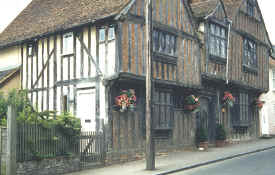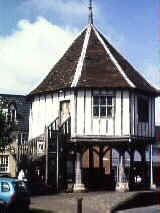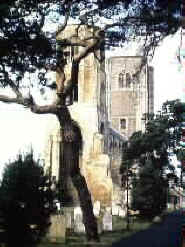| The English neglect of the region I can
only ascribe to the same sort of malady that afflicts some San Franciscans who have never
seen Yosemite, an affront for which they should be put on public display in front of City
Hall. Foreigners probably do not visit East Anglia because their holiday time is limited,
and they choose other regions that are better known. And, though there are bus excursions
available from London, one needs a car to see the area at its best. As usual, one must
make choices, and what follows is a suggested driving visit of five or six days. Use a
good map of the region, and stay on the backroads if time and navigational skills allow.
Caveat: pick up a book that describes traffic rules and parking regulations and curb
markings. Don't watch locals. They often park illegally and hope for the best.
To capture the essence of East Anglia, begin with the Lower Stour (stew'-er) River,
just east of Colchester. This is Gainsborough and Constable country, renown ironically not
so much for agriculture as the early cloth industry. Gainsborough, the portraitist and
landscape painter, was born in Sudbury, probably in 1727, and worked there for a time. His
birthplace, now a museum, can be visited. Constable, Britain's premiere landscape artist,
was born at East Bergholt in 1776. His birthplace was pulled down in the 1840s by a
neighbor who wanted to improve his view.
Constable painted some of his most famous canvases around Dedham and Flatford Mill.
Dedham is probably the most popular village in East Anglia. An important weaving town
until the mid-eighteenth century, Dedham today is tidy, quiet and picturesque. St. Mary's
Church, the present building dating from 1492, owes much to the lucrative wool trade. Walk
about the town, taking care not to miss the Flemish Cottages, originally a medieval cloth
factory. Dedham Mill, now a private home, was the last working flour mill on the Stour.
Ask at The Sun, an old coaching inn, about Elsa, their resident ghost. Don't miss tea at
the delightful seventeenth-century Essex Rose Tea Room, opposite the church.*
Drive northwestward now toward Lavenham. En route, visit the fifteenth century
Gainsborough's House, just off the town square at Sudbury, a busy market town. Lavenham is
something else. One of the most interesting medieval towns in
England, Lavenham is quiet and tranquil, a treasure of timber-framed buildings. Spend at
least a full day here. Purchase a walking-tour guide from the Suffolk Preservation
Society, just off market square. The Corpus Christi Guildhall on the square, built in 1520
as headquarters for a medieval guild, is magnificent. Now owned by the National Trust, the
structure serves as community center and a museum of local history. the most interesting medieval towns in
England, Lavenham is quiet and tranquil, a treasure of timber-framed buildings. Spend at
least a full day here. Purchase a walking-tour guide from the Suffolk Preservation
Society, just off market square. The Corpus Christi Guildhall on the square, built in 1520
as headquarters for a medieval guild, is magnificent. Now owned by the National Trust, the
structure serves as community center and a museum of local history.
Half-way through the one-mile walk, stop at The Priory on Water Street. Originally the
residence of Benedictine monks, and later medieval cloth merchants, the timber frame house
and gardens, now a private home, are open to the public. Refresh yourself at the pleasant
second-story tea room. For dinner, try the fish and chips at the pretty little pub at
Bridge Street, a nearby village.
 Make your way by scenic lanes or the more direct A-roads to
Wymondham (win'dum), a few miles southwest of Norwich. Begin at the seventeenth-century
Market Cross, a curious octagonal structure, with an enclosed second story resting on
wooden columns. The upper floor houses the tourist office. At the bottom of the square, on
Church Street, stop at the fifteenth-century Green Dragon, the oldest inn in town. The pub
has a small beamed dining room and pretty hotel rooms. Make your way by scenic lanes or the more direct A-roads to
Wymondham (win'dum), a few miles southwest of Norwich. Begin at the seventeenth-century
Market Cross, a curious octagonal structure, with an enclosed second story resting on
wooden columns. The upper floor houses the tourist office. At the bottom of the square, on
Church Street, stop at the fifteenth-century Green Dragon, the oldest inn in town. The pub
has a small beamed dining room and pretty hotel rooms.
 Continue down Church Street to the brooding double-towered abbey. From its
founding in 1107, townspeople and monks vied for control of the church. The Pope
intervened in 1249, giving the east end of the building to the monks and the west end to
the town. Each faction built its own tower. Henry VIII settled the dispute when he
dissolved the monastery and demolished the east end, happily leaving the tower. The intact
portion still serves as the parish church. Continue down Church Street to the brooding double-towered abbey. From its
founding in 1107, townspeople and monks vied for control of the church. The Pope
intervened in 1249, giving the east end of the building to the monks and the west end to
the town. Each faction built its own tower. Henry VIII settled the dispute when he
dissolved the monastery and demolished the east end, happily leaving the tower. The intact
portion still serves as the parish church.
Nearby Hingham (hing'um) is a pretty village with many Georgian houses around two
greens. The town is most interesting to Americans as the ancestral home of Abraham
Lincoln. There is a bust of the American president in St. Andrew's Church, and the town
has exchanged various monumental stones and timbers with Hingham, Massachusetts. We had
tea and scones at--what else--the Lincoln's Tea and Coffee Shop on the green. Nice place.
Some Americans will also remember Hingham for its associations with the American 452d
Bomber Group that was based nearby during WWII.
Turn north now through lovely countryside and villages to Little Walsingham, north of
Fakenham.  Walsingham has been a pilgrimage center since 1061 when
a vision of the Virgin Mary reportedly appeared here. As well as Anglican and Catholic
shrines, the village has some fine examples of architectural styles through the centuries.
The most popular pilgrimage is the walk, often barefoot, from Walsingham southward to the
Slipper Chapel at Houghton St. Giles. Walsingham has been a pilgrimage center since 1061 when
a vision of the Virgin Mary reportedly appeared here. As well as Anglican and Catholic
shrines, the village has some fine examples of architectural styles through the centuries.
The most popular pilgrimage is the walk, often barefoot, from Walsingham southward to the
Slipper Chapel at Houghton St. Giles.
While my wife shopped at the Sue Ryder gift shop on the high street, I had tea at the
pleasant coffee shop adjoining. I struck up a conversation with an elderly man who
announced that he was going to walk the path to the Slipper Chapel barefoot. "I
never!" his wife said. She leaned toward me. "He'll never make it," she
said. But he did. In the Middle Ages, the devout, including Henry VIII, walked in the
opposite direction. They left their shoes at the chapel--thus the chapel's name-- to
complete the pilgrimage barefoot to Little Walsingham.
In Little Walsingham, we stayed at the Sue Ryder Foundation Retreat House, located
behind the coffee and gift shops. Rooms are spacious, clean and comfortable, and
reasonably- priced. Meals can be taken in the coffee shop or the Retreat House dining
room. Recommended.
From Little Walsingham, drive north, then west along the scenic coast. If your journey
takes place during summer, you will be blessed with purple fields of lavender around
Heacham. Stop at the demonstration farm near the village. There are rows upon rows of
lovely varieties of lavender. An inviting pavilion for lunches and teas is set up in the
display area.
Just south of Dersingham on the A419, turn left for Sandringham. The Jacobean-style
Sandringham House has been a country home of the royal family since Queen Victoria
purchased it in 1862. The house and gardens are open to the public when family members are
not in residence. The mansion and nearby church, a small gem in Perpendicular style,
contain many memorials and memorabilia of the royal family.
Now turn westward for Stamford, long proclaimed, and justifiably, as "The Finest
Stone Town in England." Dating mostly from the medieval and Georgian periods, the
town is a happy blend of glorious past and modern vitality. A leisurely walk through the
town is quite rewarding, in spite of the busy streets and sidewalks.
The local tourist office has lately added a new boast. Stamford is the site of the
popular BBC television series, "Middlemarch," based on the novel by George
Eliot. The brochure that describes the Stamford sites used in the series was the first
offered to this tourist. I enjoyed the television presentation of "Middlemarch"
immensely, but I wonder at city authorities who make much of serving as a stage for
fiction when their town is layered in history. I bought a copy of the fine official town
guide that wisely neglects to mention the program.
End your journey with a visit to Burghley House on Stamford's outskirts. Built in the
mid-sixteenth century by William Cecil, Lord Burghley, Elizabeth I's favorite councilor,
the house is one of England's most magnificent. Cecil's descendants live there still. The
west front is surely one of the finest examples of man's handiwork. The interior and
furnishings are equally impressive. Even the facilities are regal. A bronze plaque in the
men's toilet announces that it was "Opened Privily" by the Stamford mayor on 4
May 1984.
Write to the British Tourist Authority, 551 Fifth Avenue, New York, NY 10176, for
general materials. Ask also for specific materials on East Anglia and addresses of local
tourist authorities. Here's one: Tourist Officer, Suffolk County Council, St. Edmund
House, County Hall, Ipswich, IP4 1LZ, UK. During your trip, do yourself a great favor. On
arriving in a town, make the local tourist office your first visit. They can provide the
best advice on what to see, what to do, and where to stay.
*Since publication of this article, Ian from Essex Rose informed the author that the
tea room in fact is five hundred years old, dating from the late fifteenth century. The
building is listed by the national historic buildings department of English Heritage.
Caveat and disclaimer: This is a freelance travel article that I published some
time ago. Some data, especially prices and contact information, may not be current.
Write to the
author.
Writing |
Home | Travel Articles |